Physical Address
304 North Cardinal St.
Dorchester Center, MA 02124
If you practice vascular intervention you will find yourself called to stop haemorrhage. This is one of the most challenging and rewarding aspects of practice and frequently life-saving. There are three ways you can help:
Inflow occlusion balloon: this is the ‘radiological tourniquet’ and is used to buy time in severe haemorrhage by controlling bleeding until definitive treatment is provided.
Stent grafting: this is used to treat bleeding from medium to large vessels in situations where preservation of flow is desirable.
Embolotherapy: this is the most common treatment and is used when the target vessel can be sacrificed.
Bear in mind the principles of embolization ( Ch. 35 ) and stent grafting ( Ch. 33 ). This chapter will help you to select the appropriate treatment for patients with haemorrhage.
Speed is of the essence in the management of patients with haemorrhage, irrespective of origin. Interventional radiology sits alongside surgical and endoscopic management and is often favoured, as it is relatively non-invasive and offers less of a physiological challenge than surgery to elderly and infirm patients.
The vast majority of patients will present with traumatic haemorrhage and gastrointestinal bleeding. A small minority will have massive haemoptysis or bleeding in other contexts. Management is obviously context-dependent but there are some broadly applicable basic principles.
Patient safety is dependent on achieving a balance between the phases of resuscitation, diagnosis and treatment. Deciding when it is safe to move from one stage to another comes with experience and it pays to seek senior help as early as possible. There are some important considerations.
Blood pressure and pulse: Is the patient already, or likely to, become haemodynamically unstable? If so then make sure that there is appropriate vascular access and plans for fluid and blood product resuscitation and that the place of care can offer an appropriate level of support and monitoring. In conditions where bleeding is intermittent, use the shock index as an indicator of whether the patient is actively bleeding.
Elderly patients with a shock index >1 frequently become agitated and confused and you will need assistance looking after them.
A shock index of <1 suggests that the patient is not actively bleeding and hence the yield from investigation with contrast-enhanced multislice CT scanning (CECT) is reduced. There are caveats to this, e.g.:
Patients taking a β-blocker may not mount a tachycardia
Young patients may sustain their blood pressure through vasoconstriction, despite considerable blood loss
In the ‘metastable’ patient, effective fluid resuscitation keeps up with the bleeding.
Patients with haemorrhage usually require high-dependency or intensive care. Remember that resuscitation can continue during imaging and should not lead to a delay in diagnosis, e.g. a central line can usually wait and, in any case, you may be the best person to place one.
Don't be in such a rush that the patient comes to you without appropriate support, you won't be able to focus on your job and the patient may die.
Diagnosis: this gets tricky and really depends on the clinical scenario, your role will usually be to divert the correct patients to early CECT. Remember to consider the shock index as an indication of whether there is ongoing bleeding.
If the bleeding has stopped, CECT will be negative unless there is a structural abnormality.
Endoscopy is the usual first step for patients with haematemesis; this allows both diagnosis and in many cases treatment. Patients with bright red per rectum (PR) bleeding should have proctoscopy to exclude and manage haemorrhoidal bleeding. Colonoscopy is frequently futile as the blood will obscure the view. Patients with haemoptysis will normally have bronchoscopy to try to localize the bleeding to one lung and, if necessary, as a prelude to single-lung ventilation.
Almost everyone else needs a CECT, this has replaced diagnostic laparotomy, peritoneal lavage and the vast majority of diagnostic angiography. In general, you are looking to identify the site/s of active bleeding, abnormalities likely to be associated with repeat bleeding, e.g. false aneurysm, and other important pathologies which might change patient management, e.g. inoperable cancers.
Use structured reporting forms for trauma patients to make sure that you check everything.
Do not let teams of clinicians harass you during image review. Once you have made an immediate review of the images, seek some privacy for a few minutes while you check your findings and perform reformats. The clinical team will find plenty to do with transfers and treatment.
Treatment: Interventional radiological techniques (balloon occlusion, stent grafting and embolization) complement medical, endoscopic and surgical treatments. The attraction of interventional radiology is to provide expedient and definitive management with the benefit of reduced morbidity. A good example of this is sparing the patient a laparotomy and bowel resection for lower GI bleeding. In order to decide this, the imaging must be of sufficient quality to identify the target for treatment and to plan all aspects of the procedure. Reconstructions from CECT have revolutionized the decision-making process and, in the majority of cases, the information should be sufficient to decide the approach and the techniques you will use.
Avoid falling into the trap of ‘if all you have is a hammer, everything looks like a nail’ – make sure that the dialogue with a senior member of the clinical team considers all the options.
The importance of traumatic haemorrhage is that it tends to continue unabated. Early control of haemorrhage reduces morbidity, mortality and coagulopathy and transfusion requirement. The role of imaging and intervention in trauma is changing rapidly, whole-body CECT is revolutionizing diagnosis and the value of early embolization is increasingly recognized.
In order to be effective you need to be a part of the trauma team, which means being called and preparing for angiographic intervention whenever a patient with major trauma is imminent/being scanned. If not, both you and the patient are likely to be ‘late’.
Emphasis is on saving life, so remember to use a template and provide an immediate report covering a ‘primary survey’ of the CECT looking for imminently life-threatening problems. The ABCD approach can be used:
Airway: clear or obstructed, ETT position
Breathing: flail chest, pneumothorax and lung injury
Circulation: where and what is the site of haemorrhage
Disability: brain and intracranial injuries plus obvious spinal injury.
Don't forget to notify the clinical team of the findings and document who you have informed.
Perform a radiological ‘secondary survey’ review of the CECT to look for other important injuries and pathologies and use a template for the report. Remember to look for the signs of arterial injury, which can be overlooked in the excitement of multiple fractures or solid organ injury. In the case of bleeding, consider whether it will be optimally treated by interventional techniques.
Arteries can be injured by blunt and penetrating injury and there is a spectrum of CECT and angiographic findings depending on the mechanism and severity of the injury and whether it affects the full thickness of the vessel wall or just one of the component layers. Extravasation and dissection are often obvious. Conversely, false aneurysm and abrupt occlusion of an artery due to spasm or dissection may be difficult to spot unless you review reformatted images. These ‘ cut-offs ’ usually indicate a significant arterial injury ( Fig. 49.1 ).
When an artery is injured remember to assess the territory it supplies for signs of ischaemia and consideration of endovascular or surgical revascularization.
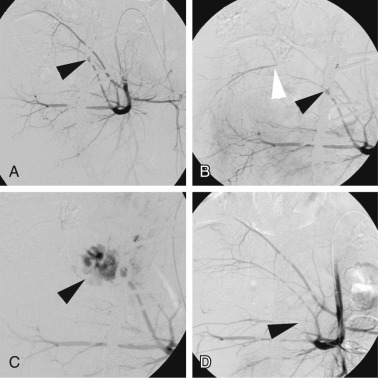
is usually manifest by contrast extravasation or false aneurysm . Spasm or dissection may lead to ‘cut-off’ and haematoma may compress or displace the parent vessel. Remember to look for abnormality in the vessel wall, a significant adventitial and medial tear in the absence of intimal injury may leave an almost normal lumen. Sometimes, bleeding will have stopped.
occurs through compression and stretching of the vessel. Minor injury causes spasm ; more severe injuries cause tears in the intima, media or adventitia, leading to intramural haematoma , dissection , occlusion ( Fig. 49.2 ), transection or avulsion / rupture of the artery.
Remember that a bone fragment may lacerate an artery following blunt trauma ( Fig. 49.3 ).
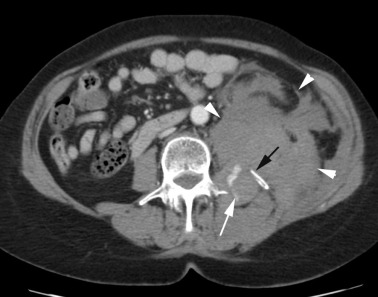
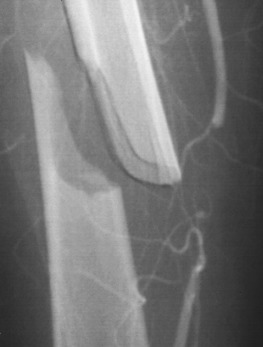
The aim of immediate intervention is damage limitation by rapid control of haemorrhage. Definitive reconstructive treatment is increasingly deferred and performed after an interval when the condition of the patient has been stabilized. In a patient with arterial bleeding from a pelvic fracture, embolization should precede surgical fixation. Patient selection is not an exact science and the decision should be based on your treatment being expedient and associated with reduced morbidity, e.g. avoiding or simplifying laparotomy or thoracotomy. If a bleeding source is identified, ask the following questions:
Does the amount of extravasation explain the patient's condition? It is possible to overlook another more significant source of blood loss or alternative cause of hypotension, e.g. cardiac tamponade. Make sure that this is the only site of bleeding.
Is the bleeding vessel supplied from a single territory? This has implications for treatment, as both the ‘front and back doors’ may need to be ‘closed’.
What would be the consequences of occlusion of the vessel? This must always be considered and is particularly important when dealing with end arteries. Do not think too long; at the end of the day it is better to be alive with a single kidney than a corpse with two.
Is embolization or surgery the appropriate intervention? Embolization is appropriate if it is likely to lead to prompt cessation of bleeding without causing significant collateral damage. Discuss the situation with a senior surgical colleague.
Is it possible to use a stent graft? This is important where preservation of flow is desirable or essential.
Don't forget that coronary artery stent grafts are available and suitable for use in small vessels (2–5 mm).
Suitable candidates for interventional radiological treatment are:
Thoracic aortic injury
A focal active bleeding source
A significant arterial injury likely to re-bleed
Any other injury likely to re-bleed.
Trauma patients should invariably have had a contrast-enhanced CT. Use the CECT reformats to plan the procedure and organize your thoughts for the surgical safety check. Consider:
What is the most appropriate access?
Are there any arterial variants in the territory that require treatment?
What catheter shapes you may require?
Whether a microcatheter is necessary?
Whether you will need to perform any non-selective angiography, e.g. to localize a bleeding lumbar artery in a diseased aorta?
Is the injury suitable for stent graft repair?
The embolic agent?
Gelfoam can be particularly useful where there are multiple bleeding points in one vascular territory, e.g. liver trauma. Use coils or vascular plugs to embolize larger proximal arterial injuries as selectively as possible and spare as much normal tissue as you can.
Consider stent grafting whenever preservation of flow is desirable in a patient with a vascular injury with extravasation or false aneurysm.
The thoracic aorta is injured either by direct compression and rupture (usually fatal) or because of shearing forces of the thoracic aorta distal to the left subclavian artery during rapid deceleration. Traumatic aortic injury (TAI) is a life-threatening condition and the vast majority of patients with complete transection of the aorta will die at the scene of the accident. Patients who survive to reach hospital will usually have a pseudoaneurysm secondary to an intact adventitia or contained haemorrhage in peri-adventitial tissue. This is an unstable injury and should be treated as though catastrophic haemorrhage is imminent. CECT should be performed on patients with a suitable mechanism of injury. Stent graft repair has become the first-choice treatment for TAI ( Fig. 49.4 ).
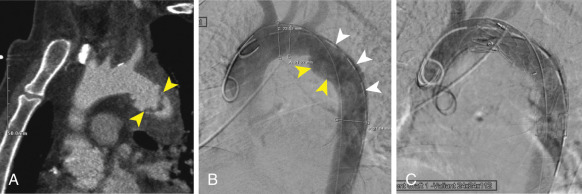
The range of clinical scenarios is virtually endless and the scope of stent grafting is always increasing, such that it is reasonable to consider using a stent graft whenever flow preservation is paramount. It is probably the first choice for significant arterial injury in the thorax and abdomen and anywhere where surgical repair would be challenging. Each case should be discussed on its own merits as there are circumstances where surgery may be preferred for other reasons.
Embolization is increasingly used in major hepatic trauma and is indicated in the presence of false aneurysm or active extravasation.
Hepatic injury is often associated with other major injuries in the abdomen, thorax and pelvis. Haemorrhage is more commonly due to venous injury rather than arterial injury. Arterial bleeding is often focal and suitable for coil embolization. However, when there are extensive lacerations, the liver may be bleeding from multiple points, then Gelfoam is particularly useful. This type of injury pattern combined with embolization is associated with a risk of hepatic necrosis or biliary injury but these can be treated at a later date if required.
will either be due to stabbing by the public or by doctors. Percutaneous transhepatic cholangiography (PTC), biliary drainage and hepatic biopsy are all common sources of referral. The typical iatrogenic injury is a small pseudoaneurysm, which will require meticulous review of the CECT for detection. Hepatic arteries are not end arteries and there are multiple intrahepatic collaterals; if possible, start coil deployment distal to the lesion to prevent collateral ‘back-door’ filling.
Blunt injury is the commonest cause and embolization is indicated in the presence of false aneurysm or active extravasation; splenic laceration alone is not an indication for treatment. Unlike the liver, the spleen is an end organ, and vigorous embolization will lead to splenic infarction with the associated risks of hyposplenism. Hence, the aim is to preserve splenic function. Two distinct forms of splenic embolization should be considered:
Selective embolization: this is the preferred option for any focal abnormality that can be readily catheterized.
Proximal embolization: this is appropriate when there is diffuse injury, e.g. multiple bleeding sites that would take too long to embolize selectively. The splenic artery is occluded proximal to the short gastric arteries; the Amplatzer plug is good for this. The aim is to maintain collateral blood supply to the spleen via the short gastric and gastroepiploic arteries, while reducing perfusion pressure sufficiently to stop haemorrhage. This technique minimizes the risk of splenic infarction but does preclude further intervention if bleeding continues.
Major pelvic trauma is often accompanied by significant arterial and venous injury. Bleeding from bone and veins stops when the fracture is stabilized with a pelvic wrap. Arterial bleeding does not respond to this and the patient requires CECT to look for pelvic arterial injury and other sources of haemorrhage.
Remember, even relatively minor pelvic fractures involving the pubic rami can cause major arterial haemorrhage ( Fig. 49.5 ). If arterial bleeding is suspected, then embolization should take precedence over surgical fixation of the fracture.
When performing angiography, the injured vessel almost inevitably lies over the fracture site.
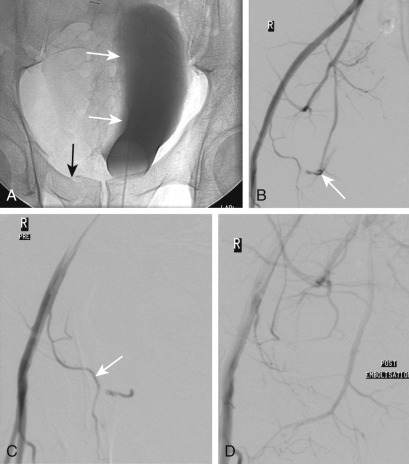
This is often iatrogenic following biopsy and can usually be embolized highly selectively. Make sure that there are two kidneys before embolization of a large amount of renal tissue. Renal arteries are end arteries, therefore there is no need to worry about collaterals, just infarction.
Be pragmatic. If the patient is haemorrhaging and unstable, stop the bleeding and sacrifice the kidney; do not waste precious time trying to perform highly selective embolization ( Fig. 49.6 ).
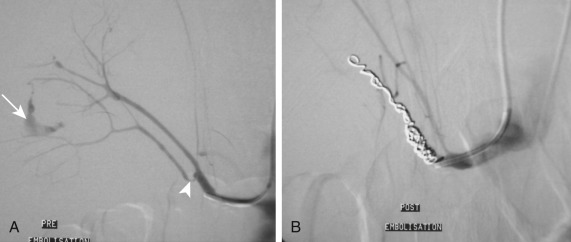
This is not uncommon in the context of penetrating injury, fractures and dislocations. Familiarity with the anatomy and understanding of the therapeutic options by you and the vascular surgeons makes endovascular treatments very popular. The increasing availability of stent grafts makes flow-preserving strategies more attractive but the management strategy depends on the needs of the patient.
The list could be endless but really distils down to you controlling the bleeding in a prompt fashion. If there is delay, then deploy a proximal occlusion balloon and discuss the situation with the clinical team and either agree that the patient's condition allows further time for catheterization and embolization or that they should have surgical repair.
Remember it is not rare for patients with trauma to re-bleed often when their blood pressure improves. This may be a result of one or more of the following possibilities:
Bleeding which had stopped at the time of CECT when the patient was hypotensive. This is often a result of spasm in smaller muscular arteries, this will restart as perfusion pressure improves.
When performing catheter angiography consider giving an antispasmodic drug in the presence of spasm or ‘cut-off’ to reveal the true condition of the artery and reveal the run-off.
False aneurysm, this is particularly common if there is leakage of bile or pancreatic secretion
Inadequate/incomplete initial embolization
Coil migration: a coil which was appropriately sized for a constricted artery in a shocked patient may be too small when the patient is normally perfused and spasm has resolved.
If there is uncertainty regarding the cause or the site of recurrent bleeding, then repeat CECT is usually warranted.
Gastrointestinal bleeding is a term which encompasses a wide range of clinical causes. Understanding the different presentations helps to localize the source of the bleeding and the likely vascular territory ( Table 49.1 ). Improvements in diagnostic endoscopy, colonoscopy, capsule endoscopy and CECT have dramatically reduced the role of mesenteric angiography in the diagnosis of both acute gastrointestinal haemorrhage and occult gastrointestinal bleeding. In occult bleeding, diagnostic angiography should only be resorted to when all other forms of investigation have failed. Even with excellent technique, the study is likely to be negative! This is a case for expertise and it is worth considering referral to a specialist centre.
| Blood loss | Likely source | Target vessel |
|---|---|---|
| Red blood PR | Left colon | IMA ( Fig. 45.18 ) |
| Right colon | SMA ( Fig. 45.19 ) | |
| Altered blood PR | Small intestine | SMA/Coeliac axis |
| Haematemesis/malaena | Oesophagus, stomach or duodenum | Coeliac axis ( Fig. 45.20 ) |
| SMA (pancreaticoduodenal arcade) |
There are two forms of unexplained long-term blood loss:
Repeated acute episodes of bleeding are often associated with a structural lesion, such as angiodysplasia. Smaller bleeds may only be recognized by the passage of blood or malaena and a drop in haemoglobin. Herald symptoms, typically abdominal pain, are usually associated with heavy bleeding, e.g. from a pseudoaneurysm. These cases should be treated as repeated episodes of acute bleeding and CECT should be performed during active bleeding.
Chronic insidious blood loss: these patients are more likely to present with anaemia, and angiography has no role in their investigation.
Become a Clinical Tree membership for Full access and enjoy Unlimited articles
If you are a member. Log in here